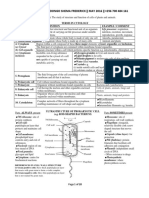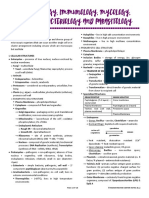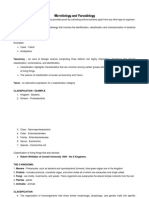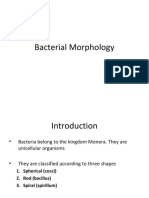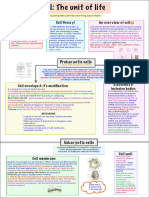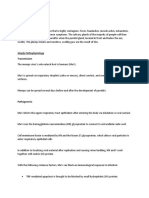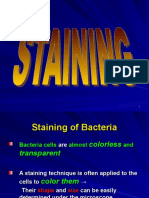0 ratings0% found this document useful (0 votes)
16 viewsOkie
Okie
Uploaded by
Febeval CastilloBacteria are unicellular prokaryotic organisms that can survive in a wide range of conditions. They have several key structures, including a cell wall, flagella or pili for movement, and a plasma membrane. Bacteria reproduce through binary fission and have short generation times. Their DNA is contained on a circular chromosome, and some bacteria also contain plasmids that can confer traits like antibiotic resistance. Bacteria come in a variety of shapes, including rods, spheres, spirals, and S-shapes, and can arrange themselves as individuals, chains, clusters, or other groupings.
Copyright:
© All Rights Reserved
Available Formats
Download as DOCX, PDF, TXT or read online from Scribd
Okie
Okie
Uploaded by
Febeval Castillo0 ratings0% found this document useful (0 votes)
16 views3 pagesBacteria are unicellular prokaryotic organisms that can survive in a wide range of conditions. They have several key structures, including a cell wall, flagella or pili for movement, and a plasma membrane. Bacteria reproduce through binary fission and have short generation times. Their DNA is contained on a circular chromosome, and some bacteria also contain plasmids that can confer traits like antibiotic resistance. Bacteria come in a variety of shapes, including rods, spheres, spirals, and S-shapes, and can arrange themselves as individuals, chains, clusters, or other groupings.
Original Description:
Goods
Original Title
okie
Copyright
© © All Rights Reserved
Available Formats
DOCX, PDF, TXT or read online from Scribd
Share this document
Did you find this document useful?
Is this content inappropriate?
Bacteria are unicellular prokaryotic organisms that can survive in a wide range of conditions. They have several key structures, including a cell wall, flagella or pili for movement, and a plasma membrane. Bacteria reproduce through binary fission and have short generation times. Their DNA is contained on a circular chromosome, and some bacteria also contain plasmids that can confer traits like antibiotic resistance. Bacteria come in a variety of shapes, including rods, spheres, spirals, and S-shapes, and can arrange themselves as individuals, chains, clusters, or other groupings.
Copyright:
© All Rights Reserved
Available Formats
Download as DOCX, PDF, TXT or read online from Scribd
Download as docx, pdf, or txt
0 ratings0% found this document useful (0 votes)
16 views3 pagesOkie
Okie
Uploaded by
Febeval CastilloBacteria are unicellular prokaryotic organisms that can survive in a wide range of conditions. They have several key structures, including a cell wall, flagella or pili for movement, and a plasma membrane. Bacteria reproduce through binary fission and have short generation times. Their DNA is contained on a circular chromosome, and some bacteria also contain plasmids that can confer traits like antibiotic resistance. Bacteria come in a variety of shapes, including rods, spheres, spirals, and S-shapes, and can arrange themselves as individuals, chains, clusters, or other groupings.
Copyright:
© All Rights Reserved
Available Formats
Download as DOCX, PDF, TXT or read online from Scribd
Download as docx, pdf, or txt
You are on page 1of 3
Characteristics of Bacteria -highly durable, resistant to extreme conditions
Function: (BACILLUS AND CLOSTRIDIUM)
1. Unicellular – one-celled organism > ex: Bacillus subtillis, Clostridium tetani, Bacillus clausii
2. No nucleus -survival during conditions of dessication, nutrient
3. Most have peptidoglycan cell wall depletion & waste build-up.
4. Divide by binary fission- asexual - resistant to heat & chemicals
5. Can use a wide range of chemical substances for -Heat Resistant by Endospores is attributed to
their nutrition Dipicolinic Acid
Bacterial Physiology Sporulation/Sporogenesis - vegetative cells form an
GROWTH endospore
Generation Time – time for the bacteria to double in Germination - endospore becomes vegetative cells.
size and split into two 5. Pili
Bacterial Replication – Binary Fission >for attachment
Bacterial Anatomy -proteinaceous, hair-like appendage; shorter, & thinner
1. Glycocalyx than flagella
- viscous, gelatinous layer composed of polysaccharide/ - for bacterial conjugation
polypeptide -pilin (protein)
(a)Slime Layer- external layer which is unorganized & (a) Common pili/ attachment pili/ Fimbriae
loosely attached -attachment or adherence, making the bacterium look
(b)Capsule- organized, firmly attached like porcupine
>loose glycocalyx (b) Sex pili/ conjugated pili/ F pili/ F
>can prevent phagocytosis thus cannot die even eaten -DNA transfer Functions: Adherence, Bacterial Mating in
by macrophagiles Conjugation,
- K ANTIGEN > systemic infection -Virulence Factor of Neisseria gonorrhea
Function of Glycocalyx: !! H- antigen- flagella
1.Prevents phagocytosis F- antigen- fimbrae
2.Adherence to tissue surface K-antigen- capsule
3.Protects against classification 6. Cell Wall
4.Inhibits nutrients from moving out of the cell -the outer covering of most bacterial, fungal, algal, &
5.Acts as a barrier to toxic hydrophobic molecules plant cells gives shape & resistance to lysis by osmotic
!! Cell wall is composed of: G(+), thick peptidoglycan shock
layer and penthoic acid; G(-), thin P.L, -consists of peptidoglycan (MUREIN)
lipopolysaccharide. G+ G-
Capsulated bacteria Thick peptidoglycan Thin peptidoglycan
Some Killers Have Pretty Nice Capsule
Teichoic Acid LPS LIPID A- ENDOTOXIN
• Streptococcus pneumoniae
EXOTOXIN ENDOTOXIN
• Klebsiella pneumoniae
!! No endo except for >can induce
• Haemophilus influenzae
Listeria monocytogenes inflammation(pamamaga)
• Pseudomonas aeruginosa
7. RIBOSOMES
• Neisseria meningitidis
-protein synthesis: 70s made up of 50s and 30s subunits
• Cryptococcus neoformans- only fungi
>targeted by antibiotics that is protein synthesis
2. Flagella
inhibitor(50s, 30 s) (for bacteria) (60s and 40 s, for
- organ of locomotion (motility)
humans)
-run & tumble movement
8. GENOME (PAIRED, LINEAR)
-chemotaxis: (movement in response to the presence of
-nuclear area or nucleoid
r chemical)
-bacterial chromosome
>hard to catch; can move
*single DNA molecule
-flagellin: (protein) >responsible for the flagella
*circular chromosome
Axial Filament/ Endoflagella/ periplasmic flagella
-plasmids (self-replicating piece of circular DNA)
- the structure for motility found in spirochetes(!ex:
>responsible for bacterial resistance
Treponema pallidum), corkscrew motion.
-SMALL, CIRCULAR, SPECIAL TYPE OF DNA ---
- are positioned beneath the bacterial outer membrane
-ANTIBIOTIC RESISTANCE
Kinds of Flagella
Bacterial Morpholog
1. Monotrichous- 1 side; 1 piece
Major shapes
2. Lophotrichous- “ponytail” . 1 side; many.
• Bacillus (plural: Bacilli) – rod shaped
3. Amphitrichous- “pigtails”. Both sides
• Coccus (plural: Cocci) – spherical
4. Peritrichous- “ferris wheel”
>Streptococci- rosary like/ strep like
5. Atrichous- no flagella
• Spirillus (plural: Spirilli) – spiral
3. Cytoplasmic Membrane
Vibrio – curve like a comma
FUNCTION:
Spirillum – corkscrew with flagella (ex: Leptos
1. Maintains Cell Integrity;
pyra)
2. Regulates Transport;
Spirochete – coiled spring without flagella
3. Specialized Function (respiration, photosynthesis,
>they are small; can only be seen in Darkfield
protein secretion)
Microscopy (ex: Treponema)
• Cytoplasm -contains the enzyme, storage granules,
Grouping Arrangements
viscous aqueous suspension of protein, nucleic acid,
1. COCCI
dissolved organic compounds, mineral salts
Diplococci – paired organism (e.g. gonococci <Neisseria
4. Endospore (bacterial spores)
gonorrhea>, pneumococci <Streptococcus
-specialized resting cells.
pneumoniae>)
Staphylococci – cluster like grapes (e.g. Staphylococcus Gram-Negative Bacteria
aureus). A. Proteobacteria
>bilog-bilog magkakasama -The proteobacteria are separated into five classes
Streptococci – chain microbes designated by Greek letters:
>strips 1. Alphaproteobacteria
Tetrads – four in groups Include nitrogen-fixing bacteria, chemoautotrophs, and
Sarcinae – cubical pockets of eight (cube) chemoheterotrophs.
2. BACILLI 1. Rickettsia
Diplobacilli 2. Ehrlichia
Streptobacilli (“strips”) 3.Bartonella
Chinese character – Diphtheria bacilli (From 4.Brucella
Corynebacterium Diphteriae) 2. Betaproteobacteria
Parallel character – Lepra bacilli (Mycobacterium -Include chemoautotrophs and chemoheterotrophs.
leprae) 1. Bordetella pertussis (causative of whooping
Bacterial Classifications cough)
• Prokaryotic organisms are classified into two domains: 2. Neisseria (meningitis)
A. ARCHAEA 3. Gammaproteobacteria
B. BACTERIA -Several medically, ecologically, and scientifically
1.Gram-Positive Bacteria important groups of bacteria belong to this class.
2.Gram-Negative Bacteria Francisella, Pseudomonadales, Moraxella,
A. ARCHAEA Coxiella, Legionellales, Vibrionales,
-This domain includes extreme halophiles, extreme Enterobacteriales, and Pasteurellales
thermophiles, and methanogens. 4. Deltaproteobacteria
B. BACTERIA Bdellovibrio and Myxococcus in the
Gram-Positive Bacteria deltaproteobacteria prey on other bacteria.
-Divided into those that have low G + C ratio and those 5. Epsilonproteobacteria
that have high G + C ratio. Include Campylobacter and Helicobacter.
1. Low G + C ratio – Curve to spirilloid-shaped
1.1. Firmicutes – Inhabits the digestive tract of animals as pathogens
-Low G + C (referring to nucleoside) gram- • Helicobacter pylori in stomach
positive bacteria are assigned to the phylum • Campylobacter jejuni in the duodenum
Firmicutes. B. Non-proteobacteria
-This group includes common soil bacteria, the • Cyanobacteria are photoautotrophs that use light
lactic acid bacteria, and several human energy and CO2 and do produce O2.
pathogens. • Purple and green photosynthetic bacteria are
1.Clostridium photoautotrophs that use light energy and CO2 and do
2. Bacillus not produce O2.
3. Staphylococcus • Deinococcus and Thermus are resistant to
4. Enterococcus environmental extremes.
5. Streptococcus • Planctomycetes, Chlamydiae, Spirochetes,
6.Lactobacillus( produces lactic acid) Bacteroidetes, and Fusobacteria are phyla of gram-
7. Listeria negative, chemoheterotrophic bacteria.
1.2. Ternericutes
-from the Latin word for soft skin, referring to
their lack of cell wall
-Includes wall-less bacteria called Mycoplasma
-Highly pleomorphic
-Produce filaments that resembles fungi (can
change their own shapes)
Ex: Mycoplasma pneumoniae ( walking
pneumonia -everywhere ; no cell wall; smallest !! catalase- catalyzes the decomposition of Hydrogen
replicating organism) peroxide to water and oxygen.
2.High G ( Guanine) + C (Cytosine) ratio -important enzyme in protecting the cell from oxidative
2.1. Actinobacteria damage by free radicals.
High G + C gram-positive bacteria are in the Catalases test uses Hydrogen peroxide(H2O2)- Bubbles:
phylum Actinobacteria. with- Staphylococcus; non- Streptococcus
– Highly pleomorphic
– Some grows filaments (which resembles
filamentous fungi)
1. Mycobacterium
2. Corynebacterium
3. Propionibacterium (/ Cutibacterium)
4. Gardnerella
5. Streptomyces (common source of antibiotic)
6. Actinomyces (fungi properties)
7. Nocardia (fungi properties) !! Aerobic rods are hard to kill via antibiotic
STREPTOCOCCUS VIRIDANS
-No group classification
-Part of the normal oral flora
-a-hemolytic
!! Legionella- (L. pneumophila – causative of Pontiac -Not inhibited by optochin
fever/ legioners disease) -Differentiate from pneumococc
!! In gram stain: violet(+); pink/red(-) >common cause of Endocarditis(if in the heart) inflamed
STREPTOCOCCI inner lining of heart.
HEMOLYSIS TEST – can disrupt/ destroy RBC Ex: Subacute Bacterial Endocarditis
1. Alpha hemolytic >gradual onset
-incomplete/ partial hemolysis >can also cause by S. aureus
-blood agar becomes greenish gray !! S. mutans- tooth decay
-Subs present responsible for hemolysis: Group D: Enterococcus faecalis
Hydrogen peroxide( Hgb to metHgb) -Part of intestinal and oral flora
>produced by bacteria which oxidizes -Most produces gamma hemolysis
hemoglobin to green Staphylococcus aureus
>Streptococcus mutans- tooth decay >facultative anaerobes
-S. pneumoniae, S. viridans >(“aureum”- gold like color) common on skin
2. Beta hemolytic- • Virulence Factors (Disable our immune responses)
-complete( ubos blood) – Protein A -surface protein; binds to igG
-colorless – Coagulase- convert fibrinogen to fibrin which causes
-Streptolysin O(sub present) bleeding or neutrophil
>toxin that causes complete hemolysis – Hemolysin
- S. Agalactiae, S. Pyogenes – Leukocidi- toxin that acts on polymorphonuclear cells
>can hemolyze whole blood – Penicillinase (Beta lactamase)
3. Gamma hemolytic Fibrin/ Fibrinogen binding protein (clamping
-no hemolysis factor) promote attachment to blood cloth
-no change in color • Penetrate through tissues
- Enterecoccus faecalis – Hyaluronidase
LANCEFIELD CLASSIFICATION- look for antigenic – Staphylokinase -reason why causes lysis
characteristics (GROUP A-D) of streptococci – Lipase
1. Group A Streptococci: Streptococcus pyogenes – Protease
-Beta hemolytic • Exotoxins (what we can get)
-Sensitive to Bacitracin (From Bacillus subtilis) … killed – Exfoliatin Toxins
-Possesses M protein ( can be seen in fimbrae of Causes scalded skin syndrome(SSS)
bacteria) – Enterotoxins
-Erythrogenic toxins (thus, redness) Bacterial supper antigen . causes diarrhea and
-Produces Streptolysin S and O vomiting (Common cause of food poisoning )
- M-PROTEIN – Toxic Shock Syndrome Toxins
CAUSE: (TSST1)- damage on skin. High fever 38.9 c leads
• Streptococcal pharyngitis ( sore throat) to shock that would lead to low blood pressure.
• Scarlet fever • Diseases by exotoxin release
>caused by strain (produce Erythrogenic toxin) seen in – Gastroenteritis (food poison)
kids, especially in tongue( “strawberry tongue”) – Toxic shock syndrome
• Rheumatic fever – Scalded skin syndrome
>Squelae (swallow S. pyogenes, spread in blood stream. • Direct Organ Invasion
Pass heart, stays. =damage in heart: difficult to open – Skin infections
and close valve. Deadly – Acute bacterial endocarditis
• Puerperal Fever – Septicemia ( from child birth) – Urinary tract infection
• Erysipelas- causes edima(accumulation of fluid) Staphylococcus saprophyticus
2. Group B Streptococci: Streptococcus agalactiae -Non-hemolytic
-Part of normal flora of vagina, mouth, urethral mucous -Coagulase negative
membrane, GIT -Novobiocin resistant
-Group B Lancefield -Causes “honeymoon cystitis”(common on sexually
-Beta hemolytic active young women/ tampon users)
•Capsule – major virulence factor Staphylococcus epidermidis
-causes neonatal meningitis (inflammation in lining in -Novobiocin sensitive
kid’s brain) , pneumonia and sepsis(bacteria spread in • Has the ability to adhere to artificial materials in the
blood) body (e.g. catheters and prosthetic heart valves)
STREPTOCOCCUS PNEUMONIAE • FREQUENTLY ISOLATED: INFECTED INDWELLING
-encapsulated cocci, non motile, lancelet-shaped, CATHETERS à PROSTETIC HEART VALVE ENDOCARDITIS
fastidious (needs other added chemicals to grow it)
-Part of oropharyngeal flora
-ALPHA HEMOLYTIC
-Lancet-shaped diplococcus
-Determined by Quellung reaction and Optochin test
!!( viridans: resistant; pneumoniae:sensitive)
!!VROPS(Virirdans Resistant Optochin Pneumoniae
Sensitive)
You might also like
- PLE 2019 - Microbiology Questions and Answer KeyDocument16 pagesPLE 2019 - Microbiology Questions and Answer Keydickson100% (4)
- CytologyDocument20 pagesCytologykaziba stephen100% (2)
- Introduction To MycologyDocument4 pagesIntroduction To Mycologysarguss14100% (2)
- Ebola: The Natural and Human History of A Deadly Virus (Norton, October 2014), by David QuammenDocument4 pagesEbola: The Natural and Human History of A Deadly Virus (Norton, October 2014), by David QuammenThe World50% (4)
- Statement of PurposeDocument1 pageStatement of Purposenauman724100% (1)
- Biotech 8 2nd QuarterDocument5 pagesBiotech 8 2nd QuarterSenpi ServerNo ratings yet
- Introduction To MicrobiologyDocument6 pagesIntroduction To MicrobiologySeon u 'No ratings yet
- Intro To MycoDocument6 pagesIntro To Mycojohn hector regpalaNo ratings yet
- Semilla, Von Reo, Activity 2 & 3Document4 pagesSemilla, Von Reo, Activity 2 & 3Von R SemillaNo ratings yet
- BingoDocument11 pagesBingoOsannah Irish InsongNo ratings yet
- Mod 6 - Micro To paraDocument18 pagesMod 6 - Micro To paraDonzzkie DonNo ratings yet
- The Cell and Its BeginningDocument6 pagesThe Cell and Its BeginningZarc VenturaNo ratings yet
- Introduction To MycologyDocument5 pagesIntroduction To MycologyJazmine Rose DelrosarioNo ratings yet
- Microbiology Notes Part LLLDocument36 pagesMicrobiology Notes Part LLLClark KentNo ratings yet
- Biology Grade 12 Unit One (Microbiology)Document12 pagesBiology Grade 12 Unit One (Microbiology)Feven AsefaNo ratings yet
- MICRODocument9 pagesMICROCyrelle Heart YoshikawaNo ratings yet
- 8 - Intro To Cestodes & D. LatumDocument2 pages8 - Intro To Cestodes & D. LatumRich NyleNo ratings yet
- Bacterial Cell Presentation2Document57 pagesBacterial Cell Presentation2rehanaNo ratings yet
- Fundamentals of Bacteriology: Bacterial MorphologyDocument8 pagesFundamentals of Bacteriology: Bacterial MorphologyShaira RamosNo ratings yet
- Morphology of BacteriaDocument44 pagesMorphology of BacteriaDr Harender SimarNo ratings yet
- General Microbiology - Lecture 2Document33 pagesGeneral Microbiology - Lecture 2Almoatazbellah AbdallahNo ratings yet
- Topic 3 Lecture 4-The Microbial CellDocument18 pagesTopic 3 Lecture 4-The Microbial CellrobertnketsangNo ratings yet
- Cell Structure and TaxonomyDocument50 pagesCell Structure and Taxonomyporkypig100% (11)
- QMS MicrobiologyDocument21 pagesQMS MicrobiologyDr-Shubhaneel NeogiNo ratings yet
- Micro DD AEDocument15 pagesMicro DD AEmostafaeldeeb2003No ratings yet
- Functional Anatomy of Prokaryotic CellsDocument28 pagesFunctional Anatomy of Prokaryotic CellsGabz GabbyNo ratings yet
- Kingdom FungiDocument11 pagesKingdom FungiPat FerrerNo ratings yet
- Morphology & Size of BacteriaDocument32 pagesMorphology & Size of BacteriaGokul VnNo ratings yet
- Bacterialmorphology 161031150548Document42 pagesBacterialmorphology 161031150548Namo namoNo ratings yet
- Pertemuan 4 Microbiology & ParasitologyDocument48 pagesPertemuan 4 Microbiology & ParasitologyRizky BluesNo ratings yet
- Micro 1 Chapter 1Document50 pagesMicro 1 Chapter 1chayiezen0301No ratings yet
- Prokaryotes and EukaryotesDocument6 pagesProkaryotes and EukaryotesC Bala DiwakeshNo ratings yet
- L2 Bacterial StructureDocument46 pagesL2 Bacterial StructureNarmathaa ThevarNo ratings yet
- Cell Structure and TaxonomyDocument50 pagesCell Structure and TaxonomyCarl Elexer Cuyugan AnoNo ratings yet
- Mycovi1 L1Document3 pagesMycovi1 L1MHEKAELLA SAMSONNo ratings yet
- Chapter 11 BiodiversityDocument18 pagesChapter 11 Biodiversityvarshenn krishnanNo ratings yet
- Micropara NotesDocument4 pagesMicropara Notesorangechicken473No ratings yet
- 2 - Bacterial Cell-08-09-2020Document26 pages2 - Bacterial Cell-08-09-2020Krishna KantNo ratings yet
- Bacterial MorphologyDocument9 pagesBacterial MorphologyJhayneNo ratings yet
- Bacterial Cell Structure 1) Capsule: Spirillum (Spiral) - Mycoplasmas Are BacteriaDocument4 pagesBacterial Cell Structure 1) Capsule: Spirillum (Spiral) - Mycoplasmas Are BacteriaTLCRNo ratings yet
- Screenshot 2022-12-19 at 1.55.39 PMDocument7 pagesScreenshot 2022-12-19 at 1.55.39 PMsopanhavortaNo ratings yet
- MicrobiologyDocument157 pagesMicrobiologygreeshmara86No ratings yet
- MCO Lectures 1-6Document20 pagesMCO Lectures 1-6sarahebrowningNo ratings yet
- Resumen Micro 2020Document94 pagesResumen Micro 2020ashley cortesNo ratings yet
- Myco LQDocument37 pagesMyco LQAngela ReyesNo ratings yet
- The Beginning of CellDocument4 pagesThe Beginning of CellTrishia Lynn MaldiaNo ratings yet
- Cytology 22Document20 pagesCytology 22lifeeternaltointerveneNo ratings yet
- Cell - The Unit of Life Mind MapDocument2 pagesCell - The Unit of Life Mind MapAshwath Kuttuva80% (10)
- Bacterial Classification As To CharacteristicsDocument27 pagesBacterial Classification As To CharacteristicscherryamorecobenNo ratings yet
- MicrobiologyDocument16 pagesMicrobiologyrj8cbfcb5jNo ratings yet
- Theriot, 5th Ed.Document284 pagesTheriot, 5th Ed.JANEEN LLARENA100% (1)
- Chapter 1 ReviewDocument6 pagesChapter 1 ReviewDung NguyenNo ratings yet
- Chapter 1,2,3 Micro PaperDocument9 pagesChapter 1,2,3 Micro Papermenamamdouh20No ratings yet
- Micro para 1Document4 pagesMicro para 1Reselle EspirituNo ratings yet
- VIRUSESDocument6 pagesVIRUSESJoanna Carla Marmonejo Estorninos-WalkerNo ratings yet
- Mycology 2019Document8 pagesMycology 2019Angellie100% (1)
- Ctruc VKDocument9 pagesCtruc VKvuvietanh0211.2002No ratings yet
- Mtle Bacte Revised 1Document35 pagesMtle Bacte Revised 1melvinsalonga2999No ratings yet
- Microbiology Notes Final-2Document58 pagesMicrobiology Notes Final-2arvindk962706No ratings yet
- MICROBIOLOGYDocument5 pagesMICROBIOLOGYCia RraNo ratings yet
- Biology Lesson 1Document4 pagesBiology Lesson 1Charles GuillermoNo ratings yet
- Microbiology: a QuickStudy Laminated 6-Page Reference GuideFrom EverandMicrobiology: a QuickStudy Laminated 6-Page Reference GuideRating: 5 out of 5 stars5/5 (1)
- Camp's Zoology by the Numbers: A comprehensive study guide in outline form for advanced biology courses, including AP, IB, DE, and college courses.From EverandCamp's Zoology by the Numbers: A comprehensive study guide in outline form for advanced biology courses, including AP, IB, DE, and college courses.No ratings yet
- Shampoo FormulationDocument4 pagesShampoo Formulationnia_27043471No ratings yet
- Pathogens and Disease As Biology Questions OCR EdexcelDocument3 pagesPathogens and Disease As Biology Questions OCR EdexcelShela HuangNo ratings yet
- MUMPSDocument4 pagesMUMPSARCTIC MOMKEYS 5EVERNo ratings yet
- Age of Child Vaccines Needed How and Where It Is GivenDocument1 pageAge of Child Vaccines Needed How and Where It Is GivenKwenaNo ratings yet
- Bakteremia E.coli EnglishDocument9 pagesBakteremia E.coli EnglishKhalda Sausan AzharNo ratings yet
- Job Descriptionof ICNDocument5 pagesJob Descriptionof ICNsari sasiNo ratings yet
- Advances in Microbiology, Infectious Diseases and Public Health Volume 7Document141 pagesAdvances in Microbiology, Infectious Diseases and Public Health Volume 7Daoud IssaNo ratings yet
- History of PenicillinDocument11 pagesHistory of PenicillinAilsa StephensonNo ratings yet
- Kingdom ArchaeBacteriaDocument20 pagesKingdom ArchaeBacteriaFrances Jhoy Lolong100% (2)
- Angel Chapter 1Document6 pagesAngel Chapter 1Rachelle Mae MendezNo ratings yet
- StainingDocument60 pagesStainingved.g007No ratings yet
- 3 BacteriaDocument19 pages3 BacteriaUzair AhmedNo ratings yet
- วิจัยสัมมนาต้นฉบับDocument5 pagesวิจัยสัมมนาต้นฉบับpatNo ratings yet
- 4.4 Emerging and Re-Emerging Infectious DiseaseDocument75 pages4.4 Emerging and Re-Emerging Infectious DiseasenorazlienaNo ratings yet
- Fasciolopsis Buski Echinostoma Ilocanum Heterophyes Heterophyes Metagonimus Yokogawai Haplorchis YokogawaiDocument26 pagesFasciolopsis Buski Echinostoma Ilocanum Heterophyes Heterophyes Metagonimus Yokogawai Haplorchis YokogawaiDeepbluexNo ratings yet
- Bactocell Shrimp Hatchery 2011Document23 pagesBactocell Shrimp Hatchery 2011ElementenergyNo ratings yet
- Performance Standards For Antimicrobial Susceptibility TestingDocument50 pagesPerformance Standards For Antimicrobial Susceptibility TestingJoseHumbertoPuenteNo ratings yet
- B.E / B.Tech Practical End Semester Examinations, October / November 2018 Third Semester Biomedical Engineering Bm8311 - Pathology and Microbiology Laboratory (Regulation 2017)Document3 pagesB.E / B.Tech Practical End Semester Examinations, October / November 2018 Third Semester Biomedical Engineering Bm8311 - Pathology and Microbiology Laboratory (Regulation 2017)KARTHINo ratings yet
- Survey of ProkaryotesDocument25 pagesSurvey of ProkaryotesBryan JanierNo ratings yet
- Clinical Laboratory Report Supreme Chalise: Test Name Result Flag Unit Reference RangeDocument1 pageClinical Laboratory Report Supreme Chalise: Test Name Result Flag Unit Reference RangeChalise SupremeNo ratings yet
- Laboratory Diagnosis of Streptococcus PyogenesDocument16 pagesLaboratory Diagnosis of Streptococcus PyogenesRima Carolina Bahsas ZakyNo ratings yet
- Dip Slides For Surfaces and in Liquids, Envirocheck®: MicrobiologyDocument1 pageDip Slides For Surfaces and in Liquids, Envirocheck®: MicrobiologyHaad AhmedNo ratings yet
- MLP and HLP Microorganisms Class VIIIDocument5 pagesMLP and HLP Microorganisms Class VIIIKPOP WORLDNo ratings yet
- ImmunizationDocument20 pagesImmunizationsarguss14100% (2)
- Articulo 1Document16 pagesArticulo 1JARLENNY ESQUIVEL MARÍNNo ratings yet
- Himor - LG3.1 2nd QuaDocument5 pagesHimor - LG3.1 2nd QuaJeff Bryan Arellano HimorNo ratings yet
- Mikrobiologi Farmasi "Virus": Anggun Hari Kusumawati M.Si.,AptDocument22 pagesMikrobiologi Farmasi "Virus": Anggun Hari Kusumawati M.Si.,AptSEPTIANA SAPUTRINo ratings yet

